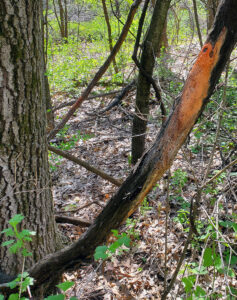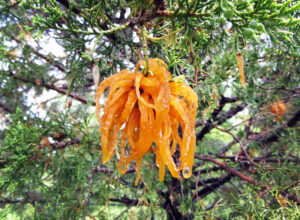
A slime mold perched on a vine.
By Michael Hillstrom, DNR Forest Health Specialist, Fitchburg;
Michael.Hillstrom@wisconsin.gov
What’s the orange goo on that tree?
Should I fight, or should I flee?
I bet forest health staff can ID!
Indeed, there are a number of types of orange goo in the woods during spring.
If it’s a lumpy mass of goo on a log, stump or mulch, then it’s probably a slime mold. Slime molds are an amoeba-like group of organisms called myxomycetes. They move very slowly to eat bacteria and organic matter. Slime molds are harmless, so unless it is covering something of value, just leave it be, and it will disappear on its own.

The spore-producing, slimy, orange gelatinous galls caused by the cedar apple rust fungus.
If you see an orange gelatinous mass on a cedar tree, then it’s a Gymnosporangium rust, such as cedar apple rust. As the name implies, these fungi need two host plants to complete their life cycle. On cedar trees, the fungi cause galls which produce slimy, orange, gelatinous appendages in the spring. If needed, galls can be pruned out.
And let’s not forget the types of orange goo covered in forest health articles by Linda Williams. White pine blister rust produces orange spore-producing pustules, and the spore-producing stages of jack pine gall rust bear either liquid orange goo or orange/yellow powder.
For more information, visit:
